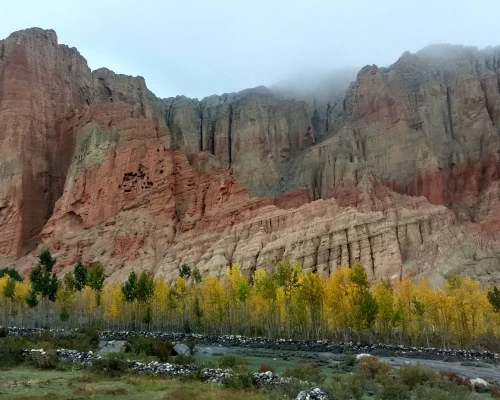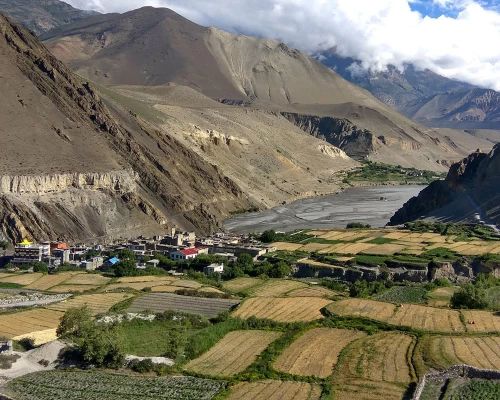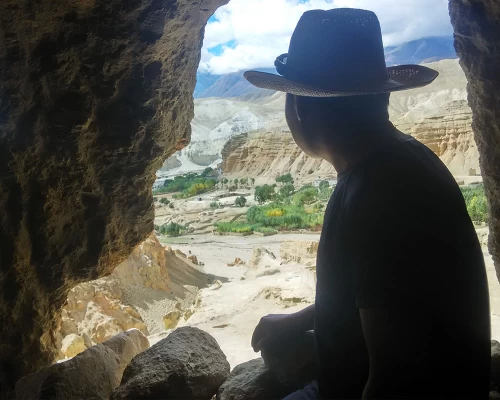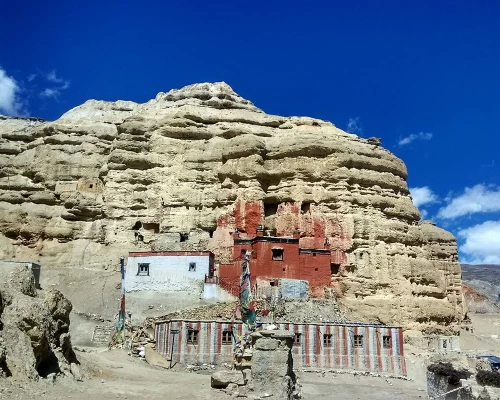Highlights
- Visit the peaceful towns of Jomsom and Kagbeni, surrounded by amazing mountain views.
- Stay in traditional Buddhist villages and learn about their unique way of life.
- Explore some of the oldest Tibetan monasteries filled with history and peace.
- Walk through ancient towns full of culture and old stories.
- Have the opportunity to see the world’s deepest gorge, the Kali Gandaki Gorge.
- Discover the walled city of Lo Manthang, known for its rich history and traditions.
- Relax at Lakeside in Pokhara and enjoy delicious food, fun activities, and beautiful lake views.
Upper Mustang Trek Overview
Upper Mustang Trek is an incredible journey through the ancient and hidden kingdom of Upper Mustang, located in the dry, rain-shadow area of the Dhaulagiri mountains in Nepal. Until the early 1990s, this area was closed to foreigners, which has helped protect its mysterious charm and Tibetan Buddhist culture. The trek lets you explore a unique Himalayan landscape, visit ancient monasteries, and experience the region’s rich traditions.
This remarkable area is along the Kali Gandaki, the world’s deepest river gorge, and offers a chance to see beautiful valleys like Lo Manthang. You will witness Buddhist traditions, take part in ceremonies and festivals, and meet local people who have kept their way of life unchanged for centuries.
Trekking to Lo Manthang and other villages in Upper Mustang is a one-of-a-kind adventure, perfect for anyone who loves history, culture, and nature. The region has stayed true to its heritage and remains largely untouched by the modern world.
Since the area is restricted, you will need special permits, and it’s best to plan your trip with a trusted trekking agency for guidance and support.
At Himalayan Joy Adventure, we offer an18 days Upper Mustang trek starting with your arrival in Kathmandu. After sightseeing in the city, you will drive to Pokhara on the third day. From there, you will take a flight to Jomsom and trek to Kagbeni, the gateway to Upper Mustang.
Once in the restricted area, the trek takes you through rocky trails, crossing mountain passes, rivers, and quiet villages like Chele, Syangboche, and Tsarang. The journey ends in Lo Manthang, the ancient capital of the Mustang Kingdom, where history and culture come alive.
There are different ways to reach Upper Mustang. You can fly to Jomsom and start trekking, follow the Kali Gandaki Valley route, or extend your trek from Poon Hill through Tatopani and Jomsom.
What makes the Upper Mustang Trek special?
The Upper Mustang Trek is a well-known trek loved by both local and international travelers, especially those who enjoy adventure. Many people come here for trekking or biking because of its unique scenery and culture. Here are nine reasons why the Upper Mustang Trek is so special.
1) A Visit to a Hidden Kingdom
Upper Mustang remained closed to outsiders until the early 1990s, which helped preserve its ancient traditions, culture, and way of life. The region has stayed untouched by modern development, making it a living museum of Tibetan heritage. As you walk through its villages and historic sites, it feels like stepping back in time, where ancient practices and customs continue to thrive just as they have for centuries.
2) Unique Himalayan Landscape
The trek takes you through a dry and desert-like area in the Himalayas, with colorful cliffs shaped by wind and water over many years. You will also find hidden caves along the way. The bare, rugged land looks even more amazing against the snow-covered mountains in the distance. This special and unique landscape is different from other trekking areas in Nepal, giving you a feeling of being in a magical and faraway place.
3) Exploring Lo Manthang
Lo Manthang, the ancient capital of the Mustang Kingdom, is a city full of history and culture. It is surrounded by tall walls built long ago to protect it from attacks. Inside the walls, you can visit the royal palace, a reminder of the city’s rich past, and explore old monasteries decorated with colorful paintings and ancient items. The city becomes lively during festivals, with locals wearing bright clothes and celebrating with music, dance, and traditional rituals.
4) Rich Tibetan Buddhist Culture
Upper Mustang is a place where Tibetan traditions have stayed the same for hundreds of years. The place is home to old monasteries, some over 600 years old, which are some of the important spiritual centers for Buddhist teachings.
Colorful prayer flags wave in the wind, carrying prayers to the sky, while carved mani walls and small Buddhist shrines (chortens) are seen along the paths, showing the deep faith of the local people.
Visitors can watch ancient rituals, like prayer ceremonies led by monks in traditional robes, and feel the peaceful and spiritual atmosphere of this sacred Himalayan region.
5) Great Weather Year-Round
Upper Mustang is in the rain shadow of big mountains like Annapurna and Dhaulagiri, so it stays dry even during Nepal’s rainy season. This makes it a great place for trekking at any time of the year, with clear skies and good weather.
While most parts of Nepal get heavy rain from June to September, Upper Mustang remains mostly dry, so you can enjoy the views and culture without worrying about the rain. Whether it’s the summer rainy season or the cold winter months, this area usually has good trekking conditions.
6) Charming Villages
During the trek, you will visit remote villages like Kagbeni and Tsarang, where life has stayed the same for many generations. These villages have traditional stone houses, narrow paths, and small local markets. The friendly people make the journey even more special, welcoming trekkers with warm smiles and showing their simple yet rich way of life. It’s heartwarming to see how these communities live peacefully with nature and keep their old traditions alive.
7) The World’s Deepest Gorge
A highlight of the trek is the Kali Gandaki Gorge, the deepest river gorge in the world. Formed by the mighty Kali Gandaki River over millions of years, this gorge is a stunning sight, surrounded by steep cliffs and towering snow-covered mountains. Its vastness and raw beauty create unforgettable views, giving trekkers a sense of nature’s incredible power and the sheer size of the landscape.
8) Adventure on Scenic Trails
The trek takes you along steep, rugged trails that wind through the mountains, offering some of the best views in Nepal. Trekkers will cross high passes with wide views of the peaks and valleys around them, making each step a visual treat.
The trail’s changing terrain, from rocky paths to river crossings, adds adventure and challenge. Whether climbing steep hills or descending into deep valleys, the ever-changing landscape keeps the trek exciting and rewarding, especially for those who enjoy a good physical challenge.
9) Peaceful and Quiet Trekking Trails
Unlike the busy trekking routes like the Everest base camp trek or Annapurna base camp trek, Upper Mustang offers peace and solitude. With fewer trekkers in the area, you can enjoy a sense of calm and escape from the noise of everyday life. The quiet landscape and peaceful villages help you connect more deeply with nature and the local culture. If you are looking for a more peaceful and reflective trekking experience, Upper Mustang is the perfect place.
How difficult is the Upper Mustang Trek?
The Upper Mustang Trek is considered moderate to challenging. The trails can be rough, with steep climbs and descents, especially as you get to higher altitudes. Some parts of the trek have rocky paths and river crossings, so it’s important to be in good physical shape.
Though it doesn’t involve technical climbing, the high altitude can make it more difficult, and some trekkers may feel symptoms of altitude sickness. It’s important to take your time and allow your body to adjust to the higher elevation.
The trek is good for people who are reasonably fit and have some trekking experience. For beginners, it might be a bit challenging, but with preparation, it’s a rewarding journey with amazing views and cultural experiences.
Upper Mustang Trek cost in 2025
The cost of the Upper Mustang trek typically ranges from USD 2,700 to USD 3,000 for a 10 to 14 day trip, which includes permits, guide, porter, accommodation, meals, and transportation.
For a more luxurious experience with upgraded accommodations and services, the cost can range from USD 4,000 to USD 6,000 or more, especially if you opt for a private trek with additional services like a personal chef or premium lodging.
At Himalayan Joy Adventure, we offer an 18 days Upper Mustang trek starting from USD 2,700 per person, which covers all basic requirements, including a start and end point in Kathmandu. The cost may vary depending on the group size. Please check below for the detailed pricing.
| No of Pax | Starting price (Per Person) |
|---|---|
| 2-5 pax | USD $2800 |
| 6-10 pax | USD $2650 |
| 11-15 pax | USD $2500 |
| 16-20 pax | USD $2400 |
| 21-25 pax | USD $2300 |
For more information about the cost of the 18 days Upper Mustang trek or to customize your departure dates and itinerary based on your preferences, you may contact us via WhatsApp.









